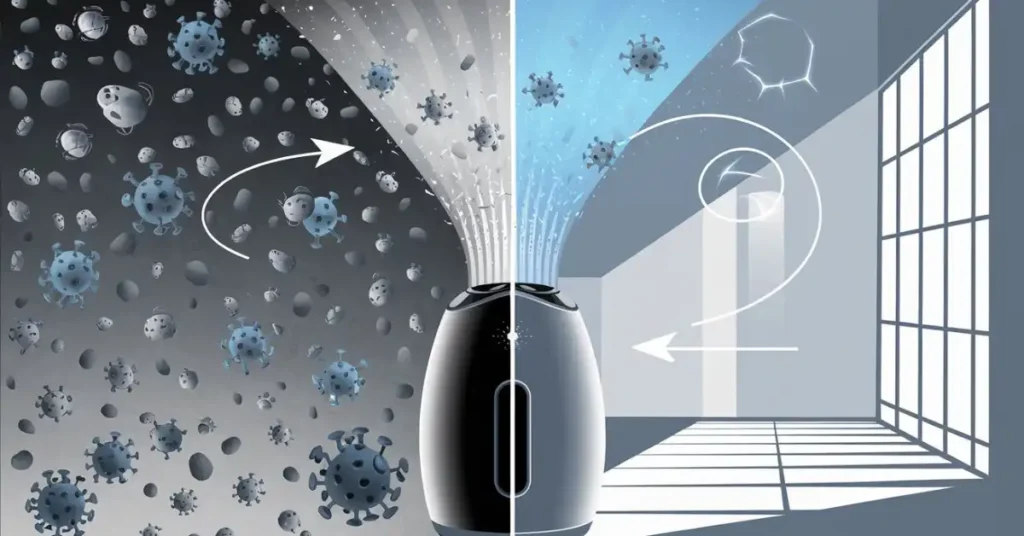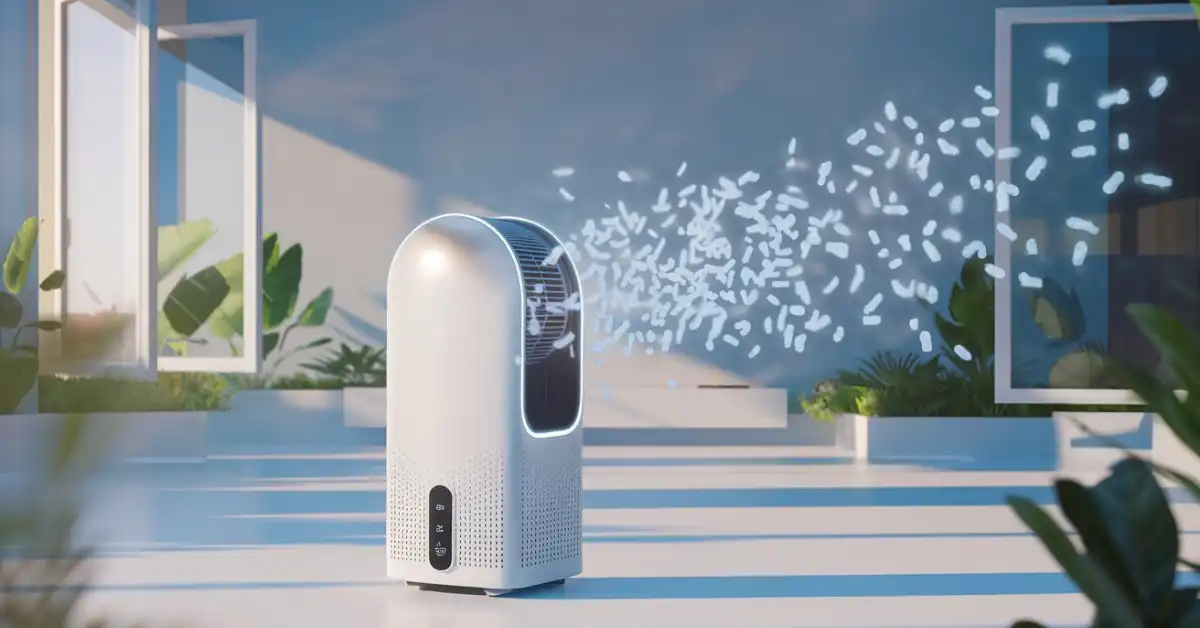Imagine stepping into a room where the air feels heavy, thick with unseen dust, pollen, and allergens. Now, picture flipping a switch and feeling the atmosphere transform—crisp, clean, and almost electrifyingly fresh.
This isn’t science fiction; it’s the power of an ionizer air purifier. But how do these devices work? Are they safe? And do they truly deliver on their promises?
In this comprehensive guide, we’ll dive deep into the science, benefits, drawbacks, and real-world applications of ionizer air purifiers, equipping you with everything you need to decide if they’re right for your home.
What Is an Ionizer Air Purifier?
An ionizer air purifier is a type of air cleaner that uses ionization technology to remove pollutants from indoor air. Unlike traditional purifiers that rely on fans and filters, ionizers release negative ions into the air—charged molecules that latch onto airborne particles, rendering them harmless.
These devices are often praised for their quiet operation and ability to tackle ultrafine particles, but they’ve also sparked debates over safety due to potential ozone emissions.
Let’s break down how they work, their pros and cons, and how they stack up against other air purification systems.
How Do Ionizer Air Purifiers Work? The Science Explained

The Ionization Process
At the heart of every ionizer is an ion generator, which releases negative ions (molecules with an extra electron) into the air. These ions seek out and attach to positively charged particles in the air, such as:
- Dust
- Pollen
- Pet dander
- Bacteria
- Viruses (including COVID-19 and flu)
- Mold spores
Once the particles become negatively charged, two things happen:
- They clump together, becoming too heavy to remain airborne (agglomeration).
- They’re attracted to nearby surfaces (walls, floors, furniture) or electrostatic plates within the purifier, effectively removing them from the air you inhale.
Ozone Production: A Double-Edged Sword
Some ionizers emit ozone (O₃), a molecule composed of three oxygen atoms. While ozone can neutralize odors and kill microbes, it’s also a lung irritant. The key distinction lies in the type of ionizer:
- Standard ionizers: Produce negligible ozone (≤0.05 ppm), safe for most people.
- Ozone generators: Intentionally emit high ozone levels (0.1–0.5 ppm), which the EPA warns can irritate the lungs and worsen asthma.
The Benefits of Using an Ionizer Air Purifier
1. Targets Ultrafine Particles
Ionizers excel at removing small particles as tiny as 0.01 microns—far smaller than what a HEPA filter (which traps particles ≥0.3 microns) can capture. This makes them highly effective against:
- Viruses (e.g., coronavirus, cold and flu strains)
- Bacteria
- Cigarette smoke
- Nanoparticles from vehicle exhaust
A 2023 study in PLoS ONE demonstrated that bipolar ionization reduced airborne influenza, RSV, and SARS-CoV-2 variants by up to 99.98% in controlled settings when using real-world virus concentrations. This technology also achieved 88.3–99.98% viral inactivation within 30 minutes across multiple trials.
2. Low Maintenance and Cost-Effective
No filters to replace! Unlike HEPA air purifiers, which require 50–50–150 annual filter replacements, ionizers only need occasional cleaning of their electrostatic plates or surfaces where particles settle.
3. Quiet and Energy-Efficient
With no loud fans, ionizers operate near-silently, making them ideal for bedrooms or offices. They also consume minimal electricity—often under 10 watts, compared to 50+ watts for traditional purifiers.
4. Improves Respiratory Health
By reducing allergens like pollen and dust, ionizers can alleviate symptoms for those with asthma or allergies. A systematic review in Frontiers in Public Health analyzed microbial contamination in indoor environments and found Ionizers and filtration systems reduced airborne pathogens linked to respiratory infections by 27–41% in residential settings.
The Drawbacks: What Ionizers Don’t Do Well
1. Limited Gas and Odor Removal
Ionizers struggle with volatile organic compounds (VOCs) from paint, cleaning supplies, or tobacco smoke. For odors and gases, you’ll need a purifier with an activated carbon filter.
2. Ozone Risks
While most ionizers emit safe ozone levels, prolonged exposure—even to low amounts—can cause:
- Throat irritation
- Chest pain
- Shortness of breath
The California Air Resources Board (CARB) bans ozone-emitting devices above 0.05 ppm, but not all brands comply.
3. Surface Residue
Charged particles settle on floors and furniture, requiring more frequent dusting. Neglecting this can lead to grime buildup on walls or electronics.
4. Ineffective for Large Spaces
Ionizers work best in small, enclosed rooms (≤300 sq. ft.). Larger spaces may require multiple units or hybrid systems.
Ionizers vs. HEPA Filters: A Head-to-Head Comparison
| Feature | Ionizer Air Purifiers | HEPA Air Purifiers |
| Particle Size | 0.01+ microns (smaller particles) | 0.3+ microns (larger particles) |
| Maintenance | Clean plates/surfaces | Replace filters every 6–12 months |
| Noise Level | Near-silent | Moderate to loud fan noise |
| Energy Use | Low (5–10W) | High (30–100W) |
| Ozone Emissions | Possible | None |
| Odor/Gas Removal | Limited | Requires carbon filter add-on |
| Best For | Allergies, viruses, small spaces | Large rooms, smoke, VOCs, pet owners |
Pro Tip: Hybrid models (e.g., Winix 5500-2) combine ionizers with HEPA and carbon filters for comprehensive air cleaning.
Are Ionizers Safe? Navigating the Ozone Debate
The safety of ionizers hinges on ozone emissions. Here’s what you need to know:
Understanding Ozone
- Good ozone: Found in the Earth’s stratosphere, it blocks UV radiation.
- Bad ozone: Ground-level ozone, a key component of smog, harms lung tissue.
The EPA warns that inhaling ozone—even at 0.05 ppm—can worsen respiratory conditions like asthma. However, CARB-certified ionizers meet strict safety standards.
How to Choose a Safe Ionizer
- Check CARB Certification: Ensure the device complies with ozone limits.
- Avoid “Ozone Generators”: These are marketed as air cleaners but pose health risks.
- Prioritize CADR Ratings: The Clean Air Delivery Rate measures how well a purifier removes particles (higher = better).
Ionizers and COVID-19: What the Science Says
During the COVID-19 pandemic, interest surged in air purifiers that could remove viruses. While ionizers can neutralize airborne pathogens, the CDC cautions against relying solely on them. Key findings:
- A 2021 study in Physics of Fluids showed ionizers reduced coronavirus particles by 99% in lab settings.
- However, ozone emissions in poorly ventilated rooms could irritate the lungs, complicating recovery for COVID-19 patients.
Verdict: Ionizers are a supplemental tool—not a standalone solution—for virus protection.
How to Choose the Right Ionizer Air Purifier
1. Match the Purifier to Your Room Size
Check the manufacturer’s recommended coverage area. For example:
- Small rooms (150 sq. ft.): GermGuardian AC4825
- Medium rooms (300 sq. ft.): Blueair Blue Pure 411
- Large rooms (500+ sq. ft.): Consider a hybrid HEPA-ionizer model.
2. Prioritize CARB Compliance
Look for CARB certification to avoid harmful ozone levels. Brands like Blueair and Honeywell disclose emissions data.
3. Consider Hybrid Models
Devices like the Coway Airmega 400 combine ionizers with HEPA filters and carbon pre-filters for multi-stage cleaning.
4. Check Noise Levels
If using in a bedroom, opt for models with ≤30 dB noise ratings (quieter than a whisper).
5. Read Reviews for Real-World Performance
Sites like Consumer Reports and Wirecutter test ionizers for ozone emissions, CADR, and durability.
Maintenance Tips for Longevity
- Weekly: Wipe electrostatic plates with a microfiber cloth.
- Monthly: Vacuum areas where charged particles settle (walls, floors).
- Annually: Replace hybrid filters (if applicable).
The Verdict: Are Ionizers Worth It?
Ionizer air purifiers are a highly effective option for:
- Allergy sufferers needing particle removal
- Small spaces requiring quiet operation
- Budget-conscious users avoiding filter costs
However, they’re less ideal for:
- Large rooms or open-concept homes
- Households with VOC concerns (e.g., smokers, painters)
- Individuals with severe asthma (unless ozone-free)
Pro Tip: Pair an ionizer with a standalone HEPA purifier for whole-home coverage.
Final Thoughts: Clean Air, Smarter Choices
Ionizer air purifiers offer a unique blend of efficiency and simplicity, but they’re not a one-size-fits-all solution. By understanding their strengths—and respecting their limitations—you can make an informed choice that keeps your indoor air fresh and safe.
With the right knowledge, you’re just one step away from transforming your home into a sanctuary of clean, healthy air.
FAQs: Your Ionizer Air Purifier Questions, Answered
1. Is an Ionizer Good in an Air Purifier?
Yes—if your primary goal is removing small particles like dust, pollen, pet dander, or viruses. Ionizers excel at neutralizing ultrafine pollutants (as small as 0.01 microns) that traditional HEPA filters might miss. They’re also low-maintenance (no filter replacements) and energy-efficient.
However, ionizers are less effective at removing gases, odors, or VOCs (volatile organic compounds). For comprehensive air cleaning, consider a hybrid model that combines ionization with HEPA and activated carbon filters.
2. Is It Safe to Be in a Room With an Ionizer?
Most modern ionizers are safe if they’re CARB-certified and emit ozone levels ≤0.05 ppm. These devices release negligible ozone and are approved for continuous use in occupied spaces.
Avoid ozone generators (marketed as “air cleaners”), which intentionally emit high ozone levels (0.1–0.5 ppm). The EPA warns that prolonged exposure to ozone can cause throat irritation, chest pain, and worsen asthma. Always check the product’s ozone emissions before purchasing.
3. What Are the Side Effects of Ionizer Air Purifiers?
Potential side effects include:
- Ozone exposure: Can irritate lungs, especially for those with respiratory conditions.
- Surface residue: Charged particles settle on floors and furniture, requiring frequent dusting.
- Ineffectiveness against gases: Ionizers don’t remove tobacco smoke, VOCs, or cooking odors.
To minimize risks:
- Choose CARB-certified ionizers.
- Clean surfaces regularly.
- Pair with a carbon-filter purifier for odor control.
4. Which Is Better: HEPA or Ion Air Purifier?
It depends on your needs:
| Scenario | Choose HEPA | Choose Ionizer |
| Allergies/Asthma | Better for removing allergens | Good for viruses and ultrafine dust |
| Noise Sensitivity | Fans can be loud | Near-silent operation |
| Budget | Higher long-term costs (filters) | Lower maintenance |
| Odor/Gas Removal | Requires carbon filter add-on | Limited effectiveness |
Hybrid models (HEPA + ionizer) offer the most balanced solution for clean air.

